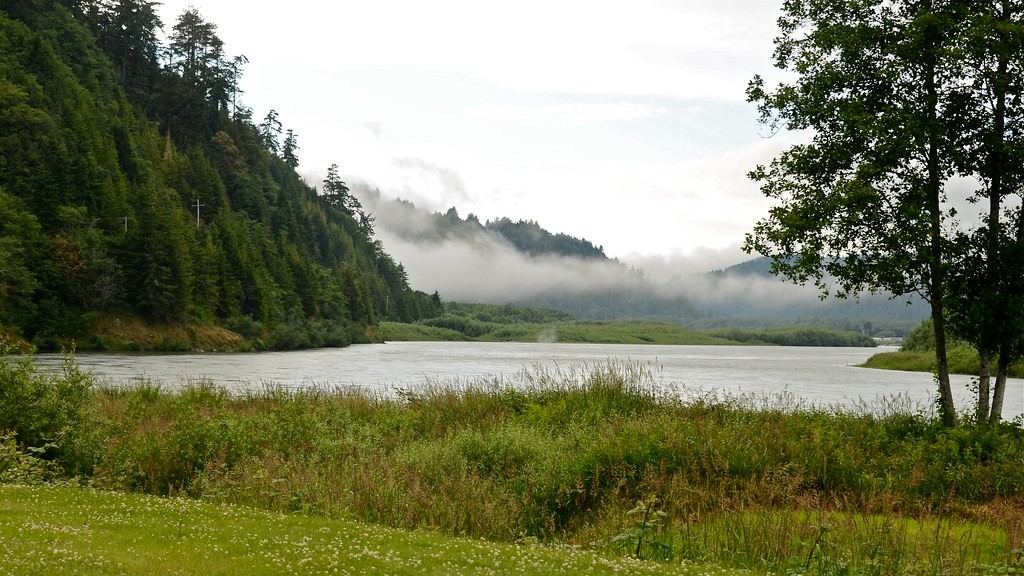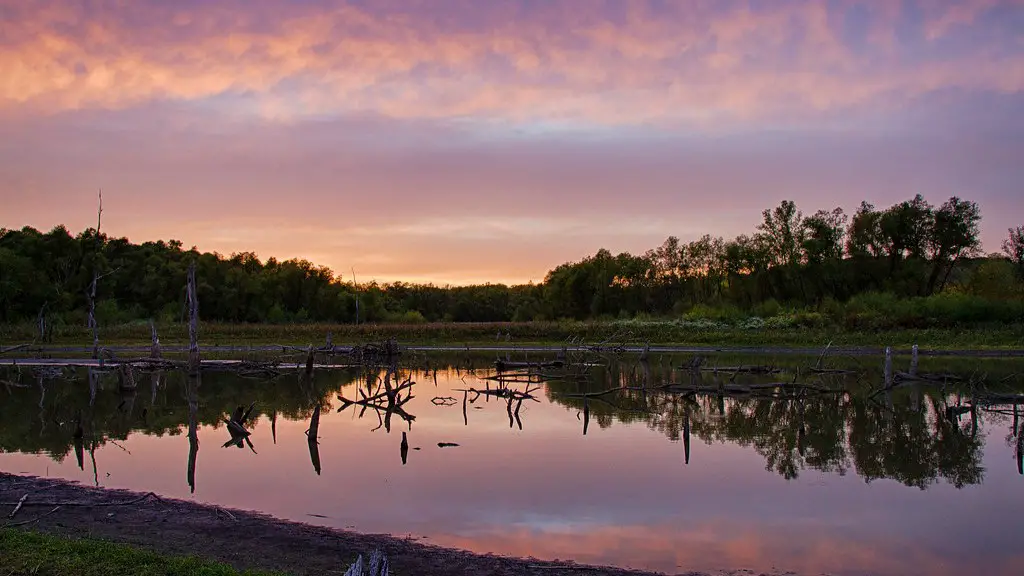Mississippi River flows into which Ocean or Sea
The iconic Mississippi River is a major river that crosses North America, extending from Itasca, Minnesota south to the Gulf of Mexico. The river is the second-longest river in North America, with a total length of over 2,320 miles and a drainage area of 1,151,000 square miles, covering all or part of 32 US States and two Canadian provinces. It has the largest watershed in the United States, feeding into many other streams, rivers, lakes and wetlands throughout the region.
Along its course, the Mississippi River creates many different shapes and forms. It creates oxbow lakes, bayous, and other wetlands. In some places, like the Atchafalaya Basin, the river is wide and slow-moving, while in other places, like its mouth at the Gulf of Mexico, it is fast and powerful. All along its course, the Mississippi River supports a wide diversity of wildlife, including hundreds of fish species, aquatic birds and mammals.
At the end of its journey, the Mississippi River empties into the Gulf of Mexico. This great body of water is a large oceanic inlet of the Atlantic Ocean and the world’s eleventh-largest body of water. It has an area of 600,000 square miles and is bounded by Mexico to the west, Cuba to the south, the United States to the east and the Yucatán Peninsula to the east. The Gulf of Mexico is home to a vibrant and diverse array of ocean life, including turtles, dolphins, sawfish and numerous other species.
The meeting of the Mississippi and the Gulf of Mexico is important to both the river and the ocean. It provides nutrients and oxygen to the ocean, helping to sustain its diverse and abundant marine life. It also helps to buffer the river against storms and floods. In addition, the Mississippi helps actively to build and sustain the beaches, coastal marshes and estuaries along the Gulf of Mexico.
The Mississippi in its journey of over 2,320 miles has been important in shaping the land that it passes through and the lives of the people who inhabit its banks. Its importance continues into the Gulf of Mexico, both as a source of resources and energy, as well as in its effects on the environment. The meeting of the Mississippi and Gulf of Mexico has required the two to coexist and to interact with each other in a mutually beneficial manner.
Gulf of Mexico Oceans Currents
The Gulf of Mexico offers a unique set of ocean current phenomena. It is a highly productive and economically important body of water with both deep and shallow currents occurring in different areas. The deep Gulf Current flows southeast along the Gulf Coast, while the shallow Gulf Stream, also called the Mississippi-Alabama Current, flows westward along the northern coastline. The shallow coastal current carries warm and cold water, creating upwelling, downwelling and meandering effects along the coastline.
The depth of the sea and geography of the coastline determine the currents, resulting in a variety of habitats that support a diverse and abundant ecosystem. In the deeper, pelagic areas and the open sea, there are large migrations of fish and other marine life. In contrast, the shallow coastal marine environment is rich with benthic life, such as oysters, shrimp, crabs and blue crabs. This unique biodiversity attracts many recreational and commercial fishing activities.
The Gulf of Mexico also experiences seasonal water circulation patterns which are driven by the combination of winds than drive surface water currents and their interaction with the ocean’s depths. A semi-permanent low pressure zone located in the northwest of the Gulf, known as the Loop Current, is the main driver of water circulation within the basin. More than half of the waters from the Gulf Stream current is drawn from the Loop Current and the warm, northern waters they bring.
Mississippi River Delta Formation
One of the most significant features created by the intersection of the Mississippi River and the Gulf of Mexico is the Mississippi River Delta. This large area of sediment and organic material forms a buffer between the raw power of the current of the Mississippi and the relatively calm waters of the Gulf. The delta is made up of multiple layers of sand, silt, clay and other minerals, built up over centuries.
These sediment deposits provide a rich habitat for numerous birds and reptiles, as well as a wide range of aquatic species, including endangered species like sea turtles, dolphins and manatees. While the delta is an important part of the ecosystem in the Gulf of Mexico, it is also highly vulnerable to its changing environment. Over the years, a combination of human activities and natural forces has led to the delta’s gradual erosion and disappearance.
Apart from providing a layer of protection from coastal flooding, the delta also serves an important role in preventing the backward flow of saltwater from the ocean into the freshwater flow of the Mississippi. Without the delta, the river could become less fresh, eventually leading to contamination of nearby wetlands and other aquatic ecosystems.
The entry of the Mississippi River into the Gulf of Mexico is a vital part of the ecosystems in both environments. It provides nutrients and oxygen to the Gulf, while helping to buffer the river against storms and floods. Together, the Mississippi River and the Gulf create a unique cultural and economic landscape that millions of people depend on for a variety of resources and energy. The meeting of the Mississippi and the Gulf of Mexico is an important reminder of the vital connection between land, water and people.
Risk of Pollution
The intersection of the Mississippi River and the Gulf of Mexico is also home to a variety of human activities. This can have a direct effect on the ecosystems of both bodies of water, leading to a range of negative impacts such as deforestation, development and pollution.
The most common form of pollution in the Mississippi/Gulf area is agricultural runoff. This often contains dangerously high levels of nutrients and other pollutants, which can lead to hypoxic zones and dead zones in the ocean. These areas are unable to produce enough oxygen, leading to the death of fish, aquatic plants and other organisms.
Oil spills, though rare, can also have a major effect on the Gulf. In February 2020 the state of Louisiana experienced an oil spill from the Mississippi River posing a risk to nearby wetlands and habitats. Such accidents can cause a range of environmental damage, from killing wildlife to leading to long-term health and ecological consequences.
The Mississippi River is one of the largest rivers in the world, flowing for over 2,000 miles into the Gulf of Mexico. Its entry into the Gulf of Mexico has a huge impact on both bodies of water, from providing nutrients, oxygen and protection to the Gulf, to helping build and sustain beaches, coastal marshes and estuaries along its shores.
Environmental Impacts
The considerable presence and natural force of the Mississippi River can have both positive and negative impacts on the environment. The river picks up sediment and organic material as it passes through different areas, and these deposits can have a positive effect, such as contributing to the formation of the Mississippi Delta. However, they can also contribute to the silting-up of channels, which can increase the risk of flooding.
In addition, the instability of the river’s ever-changing course can lead to over-deposition of sediment and to changes in the local hydrology. This can disrupt the balance of aquatic ecosystems, leading to the destruction of habitats and the loss of biodiversity. In extreme cases, the river can even cause the formation of oxbows, meanders and other bodies of water that restrict or hinder the flow of water.
Human activities such as deforestation, development and pollution also have a detrimental effect on the environment. As in other parts of the world, pollution is a major problem in the Mississippi/Gulf area, with agricultural runoff and oil spills the two main sources of unsafe levels of pollutants.
The intersection of the Mississippi River and the Gulf of Mexico has a substantial impact on both bodies of water. The meeting of the large river and the ocean provides many benefits, while at the same time posing a number of potential risks. It is therefore essential that we work together to ensure the protection of both the Mississippi River and the Gulf of Mexico, while also finding ways to use their resources in a sustainable and environmentally responsible way.
Economic Opportunities
The connection between the Mississippi River and the Gulf of Mexico has big economic benefits for the people and communities of the region. The proximity of the two bodies of water allows people to take advantage of the resources found in each. This includes fishing, hunting, tourism and shipping, all of which bring economic benefits to the local area.
Fishing is especially important for many communities in the region. Recreational and commercial fishers take advantage of all the marine life found in the Gulf of Mexico, from turtles and dolphins to oysters and shrimp. The Mississippi River also provides an abundance of freshwater fish species, including bass, catfish, gar and carp.
The Gulf of Mexico also offers a range of recreational activities, such as swimming, snorkeling, kayaking and boating. The presence of the Mississippi River in the Gulf has made it more accessible to people of all backgrounds, and tourism has become an important source of income for many individuals, communities and businesses.
In addition, the presence of the river in the Gulf of Mexico is also beneficial for shipping, with the Mississippi’s ports providing a crucial link between the United States and the Caribbean. This is an important source of revenue for ports and shipping companies, as well as for the local economy.
The intersection of the Mississippi River and the Gulf of Mexico is a unique feature of the region and one that can bring prosperity and economic opportunities to those who inhabit it. The connection offers abundant resources and energy, while also helping to protect against storms, floods and other environmental challenges. It is therefore important to recognize the significant economic opportunities that are offered by the relationship between the river and the sea and to work together to maximize their potential.
Conclusion
The intersection of the Mississippi River and the Gulf of Mexico is an important feature of the landscape and is integral to the economies, cultures and people of the region. Its physical meeting of the two bodies of water has a big impact on the ecosystems of both the river and the ocean, providing nutrients and oxygen as well as protection for the Gulf of Mexico against storms and floods. In addition, their proximity is of great economic benefit to the communities, offering a range of resources and energy, from fishing, hunting and tourism to shipping.
The intersection of the Mississippi River is a reminder of the connection between land, water and people that is so fundamental to our environment and to our lives. We must all work together to protect the vast and diverse ecosystems of the region, while also finding ways to make the most of the economic opportunities that the relationship between the river and the sea offers us.





